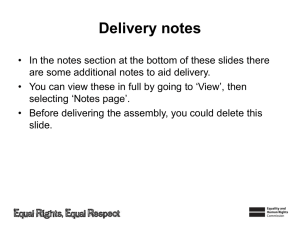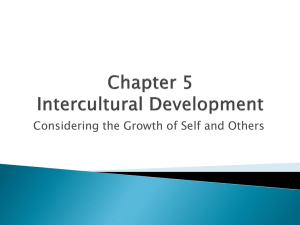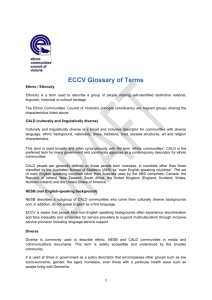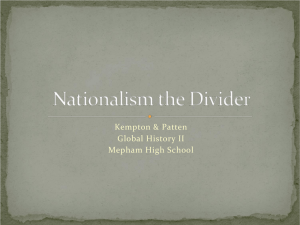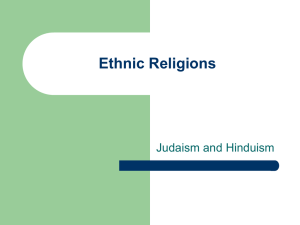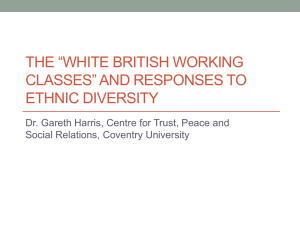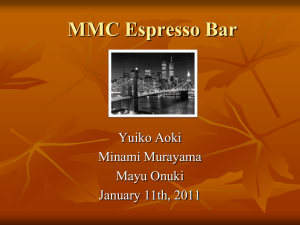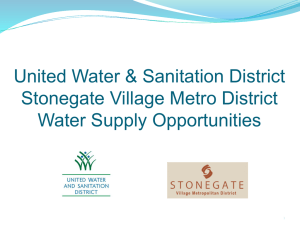The Untold Story of Australian Multiculturalism: How
advertisement
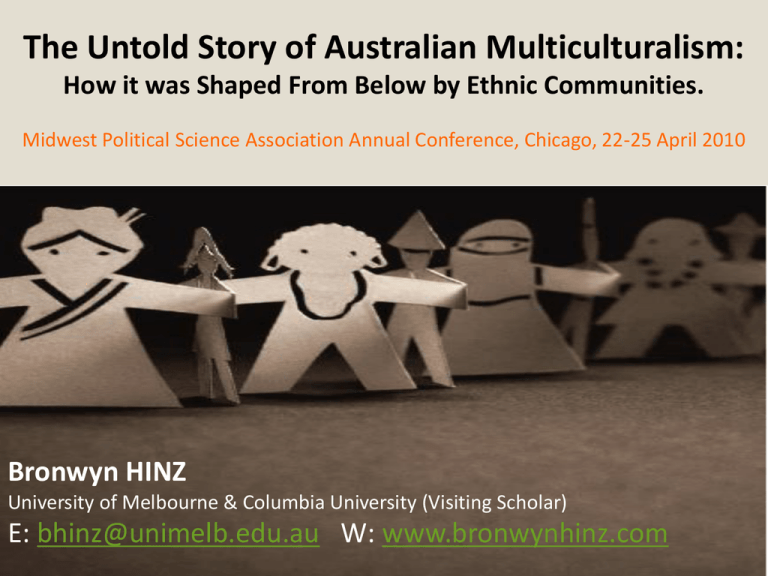
The Untold Story of Australian Multiculturalism: How it was Shaped From Below by Ethnic Communities. Midwest Political Science Association Annual Conference, Chicago, 22-25 April 2010 Bronwyn HINZ University of Melbourne & Columbia University (Visiting Scholar) E: bhinz@unimelb.edu.au W: www.bronwynhinz.com A remarkable transformation In the last 60 years, Australia has transformed from a country 95 per cent white and 90 % British, to country where half the population was born overseas or has at least one parent born overseas, from over 260 countries. This dramatic change in racial and ethnic composition was accompanied by an equally dramatic reversal in community attitudes to immigration, and to racial and cultural diversity – from 90% opposed in the early 1970s, to 90% in favor in 2009. Achieved without any violent, social or political upheavals. Research to date: limited in size and scope, ‘top-down’ approach, ignores or underplays role of migrants, participatory policy?.... Transformation attributable in large part to direct role of migrant and ethnic communities in shaping Australia’s multicultural policies and programs • 2 year study of Australia’s oldest federation of migrant, ethnic and multicultural groups – the Ethnic Communities’ Council of Victoria (ECCV). – Interviews, data & doc analysis (previously unexplored archives); triangulation. – Qualitatively analysed, drawing upon participatory politics and network theory • First study of the united, pan-ethnic movement in Australia. Interesting organisation – in both senses of the word • New perspective and knowledge of Australian political history, insights for grassroots communities, and governments negotiating multicultural issues. A history of racial and ethnic exclusion • 1901 ‘Immigration Restriction Act’ (White Australia Policy) – First legislation passed by federal parliament. Very ‘successful’ • 1946 Mass migration program (“populate or perish”); assimilation policy demanded migrants required to ‘become indistinguishable’ from other Australians. – ‘My hope that for every foreign migrant, there will be 10 from the UK’ (Immigration Minister Arthur Calwell) • 1972 – White Australia Policy officially discarded (but many racially discriminatory policies and attitudes remain). • Continuing obstacles to social, eco and political participation, But lack of united migrant voice limits political influence. Foundation and structure - 1973 Ethnic leaders discuss mutual concerns - 1974 Immigration department abolished = catalyst for creation! 180 leaders from 22 ethnic backgrounds vote to establish the Ethnic Communities’ Council of Victoria (ECCV) ‘a permanent, representative council to systematically incorporate the migrant and ethnic communities’ voice in Australia’s political, media and social institutions’. - ECCV structured to maximize inclusiveness and influence - Members were migrant and ethnic groups. - Elected executive committee, volunteer policy committees, forums - Direct involvement - anyone from member groups could participate - Policy community and issue network - This umbrella structure gave them legitimacy to speak on behalf of ethnic/migrant sector and additional advocacy opportunities and influence denied to other organisations. Objectives • Promote cooperation amongst ethnic communities; • Provide forum for consultation between ethnic groups, gov and community; • Improve participation of ethnic communities; • Represent ethnic groups in policy formation; • Promote a culturally pluralistic Australia within overall concept of national unity… All policy areas – but especially settlement, education and media Campaign that ‘assimilation approach’ replaced by “a more integrative approach where Australians of all backgrounds could maintain their cultural distinctiveness without prejudice, whilst also appreciating and absorbing the cultural practices of others” Some of their many successes Federal level – Adoption of multiculturalism by Whitlam government; institutionalization of multiculturalism under Fraser government – Australia’s first ever dedicated refugee policy – Ethnic broadcasting: radio 3zz and 3zzz, radio/tv 3ea/SBS – Immigration policy framework – esp 1980s – Citizenship test revisions… State level – Ethnic Affairs Commissions (establishment and management!) - Curriculum and education policy - Public health (eg AIDS awareness campaigns) - Health and criminal justice reforms –translators, nonEnglish info - Multicultural Victoria Act, Charter of Rights and Responsibilities… Strategies (top 3) • Personal connections with (prime) ministers and other key policy actors. • Positions on government advisory and consultative bodies – Held positions on almost major committees of relevance, and were consulted by the rest, both formally and informally. Up to 60 bodies in any single year, and 20 in education alone in 1984 • Internal lobbying, info gathering and campaigns – Through vast network of member groups & media Success factors – lessons for other grassroots federations • Structure – Umbrella body = 100s connections to other organisations (gov and non-gov) through members. Extended influence and information gathering. – Policy community and issue network. – Peak representative body = allowed it access to policymakers, media denied to other less-representative groups. – Dependence on member organisations – ensured that ECCV reflected changes in ‘ethnic’ composition of population over time, and pursued their policy preferences -> maintains representative legitimacy • Leaders – Managing internal differences (ethnic and cultural backgrounds, political differences, preferred strategies) AND strongly pushing ECCV agenda in political circles, media and with other stakeholders. • Not money - Most influential when had least money and not even permanent offices….. Challenges • Waning influence? – Most objectives met? Discrimination and disadvantage much lower – Gov assumption of their role? • Forces them to re-invent themselves and their role – evolving into think-tank and ‘gov partner’ relying on professional staff, rather than grass-roots lobby group relying on volunteers • Reliance on gov grants - redirects policy and personnel to gov priorities • New issues: pursuing ‘community’ issues rather than immigration/settlement and service access. • Decline in mass participation in voluntary organisations • Change in society –too broad and diverse to represent? • Challenges are growing to both the concept and practice of multiculturalism in Australia Conclusions and moving forward • ECCV and other peak migrant bodies actively involved in creation, adoption and defense of multicultural policies and practice. – Not ‘top-down’ in a vacuum like previous research suggested • Power of grassroots federations • Most important: Connections (networks, personal), leadership and independence. Not money! • Future research: comparative studies … …with peak non-government advocacy bodies and federations in other policy areas are needed. …of pan-ethnic movements in other countries Bronwyn Hinz University of Melbourne Columbia University (Visiting Scholar) www.bronwynhinz.com Book available: Australian Scholarly Publishing (www.scholarly.com.au) & www.amazon.com
